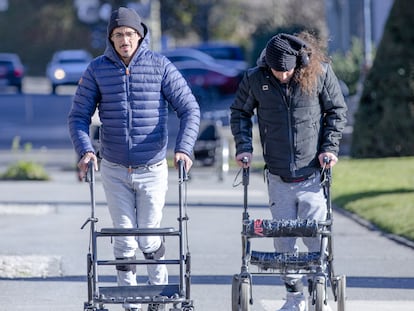Researchers discover hormone capable of strengthening bones
A new study has found a possible explanation for why nursing mothers maintain robust bone mass despite calcium loss. The discovery, in the laboratory, opens the door to treatments against osteoporosis

Science has begun to unravel an old mystery regarding the human body and breastfeeding. Until now, there was no explanation for why most lactating women are able to maintain relatively strong bone health despite allocating their body’s calcium reserves to producing milk to breastfeed their babies. A group of researchers from the University of California has shed light on this enigma and, in a study in mice and human cells published in the journal Nature, the authors describe for the first time a hormone, called CCN3, that is capable of strengthening bones. The finding — which will have to be confirmed in humans — opens the door to new research into therapeutic targets against osteoporosis, a disease characterized by decreased bone density, which can cause fractures.
Anyone can suffer from osteoporosis, although women over the age of 50 are at greater risk. The female body uses estrogens (sex hormones) to preserve bone mass, but when this hormone is depleted due to menopause or anti-hormonal therapies, bone tissue degrades: bones become more porous and fragile, less resilient to trauma and break more easily. This happens whenever estrogen falls, except in one context: breastfeeding.
In this case, there is a drop in the female sex hormones, but, surprisingly, estrogen and bone health no longer seem to be connected, the study explains. Despite the drop in levels of estradiol (a type of estrogen) and the increase in bone remodeling — the process of bone restructuring, which is constantly removing old tissue and forming new — to meet the calcium demand of babies during breastfeeding, the mother’s bone mass is largely maintained. Although it is not impossible, osteoporosis or fractures are rare. But it was not known why.
The new study published in Nature is one step forward in the University of California researchers’ efforts to resolve this mystery, says Holly Ingraham, lead author and professor of Molecular Cellular Pharmacology at the University of California in San Francisco. In genetically modified mice that had an estrogen receptor located in a cluster of neurons in the hypothalamus removed, the researchers found that in females, but not males, huge increases in bone mass occurred.
“In follow-up studies over the next five years, we discovered that this bone phenotype occurred due to a circulating factor [vectors of communication between cells and tissues in the body]. Finally, we narrowed down the potential factors to CCN3. This hormone comes from the brain and looks like a growth factor. It is capable of forming strong bones and repairing fractures. We then showed that it is significant in control females [and not only in mutants] during lactation,” says the researcher in an email response.
CCN3 has been named the “maternal brain hormone.” It is located in the hypothalamus — a region of the brain that controls hormone production — but is only present in female mice and during lactation. Ingraham explains that this substance acts on skeletal stem cells, which will become bone and cartilage. “CCN3 can be found in several tissues, including the brain, but we believe it is released into the blood only in nursing mothers because it is produced in neurons that reside near one of the four fenestrae of the brain: these are leaky regions, where hormones can enter or leave the brain. We suggest that CCN3 is manufactured to ensure that enough bone can form while being deprived of calcium to produce milk during lactation,” says Ingraham.
Studies are now underway into the therapeutic potential of this hormone. For now, researchers have confirmed that it improves fracture repair when administered in laboratory bone models, and in mice. “We gave this hormone to control mice [young and old females, females without estrogen and males]. In all cases, it built and strengthened bones. We also show in human bone stem cells that CCN3 is anabolic [favors the creation of bone] and increases mineralization or osteogenesis [the process of bone tissue formation],” says the scientist.
Ingraham admits that this research is still in the very early stages, and they have yet to measure the hormone in women. But her team are already beginning to study what happens with CCN3 outside the context of breastfeeding. “Based on our mouse models, we suggest that this hormone remains inactive during periods without pregnancy, during pregnancy, and in periods after weaning. It only appears during breastfeeding.” However, beyond its function to strengthen the bone while the mother breastfeeds, Ingraham says it’s possible that it may have other functions that are yet to be discovered. “Once we identify the receptor for this hormone, we will know more,” she says.
Therapeutic potential against osteoporosis
In practice, the finding opens the door to new lines of research against osteoporosis, which affects one in three women and one in five men over the age of 50. “Although there is still much more to do, we are excited to translate this discovery to many skeletal-related conditions, such as osteoporosis, fracture repair, genetic disorders such as osteogenesis imperfecta, treatment of premature bone loss that occurs in women who receive anti-hormonal therapies, cartilage regeneration and dental implants,” says Ingraham.
The researcher also highlights that this discovery would have been impossible without female mice, who are rarely studied in scientific research, since male animals are prioritized. “I firmly believe that efforts to take advantage of hormonal fluctuations and dynamic phases of female physiology throughout life will lead to new biological discoveries that will be relevant to both women and men, as our study shows. The physiological responses necessary to become pregnant, maintain a pregnancy, and care for offspring are profound and unique to women. Solving scientific puzzles regarding sex differences or women-related conditions and closing funding gaps for women’s health will improve everyone’s health,” she says.
Pilar Peris, rheumatologist at the Hospital Clínic of Barcelona and member of the metabolic bone pathology working group of the Spanish Society of Rheumatology, says the study’s explanation of the link between the brain, hormones and bone during pregnancy and lactation is “very interesting,” but calls for caution. “This whole theory seems interesting, but it is a study in mice. We do not have data in humans.”
Esteban Jódar, member of the Mineral and Bone Metabolism Group of the Spanish Society of Endocrinology and Nutrition, agrees that the study is “attractive as a potential therapeutic target,” but says further study is needed. “Molecular biology reveals to us how part of physiology, but also pathophysiology, works. Therefore, it can give us a target that we can manipulate and access with disease treatments. If this molecule allows us to identify a way to generate more osteoblasts [bone cells involved in the formation of bone tissue], it is a potential therapeutic target,” says the endocrinologist, who did not participate in the study.
Jódar points out that, although there are already drugs against osteoporosis — especially focused on preventing more bone loss (catabolic), although there are also some that promote bone formation (anabolic) — “it is not a perfect arsenal.” “We reduce hip fractures by 50% and multiple vertebral fractures by more than 80%. It’s very good, but a new target would be very welcome, especially if it increases bone formation,” he says.
Sign up for our weekly newsletter to get more English-language news coverage from EL PAÍS USA Edition
Tu suscripción se está usando en otro dispositivo
¿Quieres añadir otro usuario a tu suscripción?
Si continúas leyendo en este dispositivo, no se podrá leer en el otro.
FlechaTu suscripción se está usando en otro dispositivo y solo puedes acceder a EL PAÍS desde un dispositivo a la vez.
Si quieres compartir tu cuenta, cambia tu suscripción a la modalidad Premium, así podrás añadir otro usuario. Cada uno accederá con su propia cuenta de email, lo que os permitirá personalizar vuestra experiencia en EL PAÍS.
¿Tienes una suscripción de empresa? Accede aquí para contratar más cuentas.
En el caso de no saber quién está usando tu cuenta, te recomendamos cambiar tu contraseña aquí.
Si decides continuar compartiendo tu cuenta, este mensaje se mostrará en tu dispositivo y en el de la otra persona que está usando tu cuenta de forma indefinida, afectando a tu experiencia de lectura. Puedes consultar aquí los términos y condiciones de la suscripción digital.
More information
Archived In
Últimas noticias
Most viewed
- Sinaloa Cartel war is taking its toll on Los Chapitos
- Oona Chaplin: ‘I told James Cameron that I was living in a treehouse and starting a permaculture project with a friend’
- Reinhard Genzel, Nobel laureate in physics: ‘One-minute videos will never give you the truth’
- Why the price of coffee has skyrocketed: from Brazilian plantations to specialty coffee houses
- Silver prices are going crazy: This is what’s fueling the rally










































